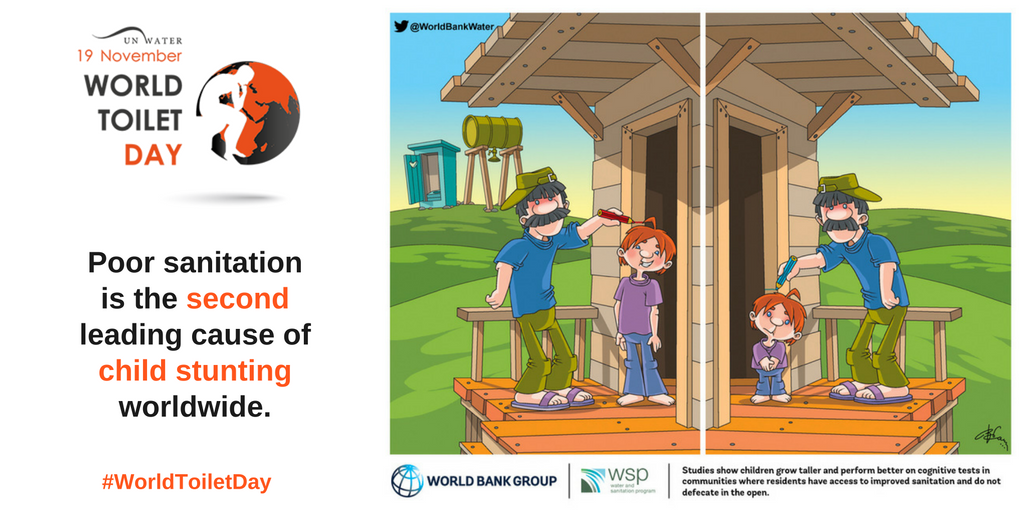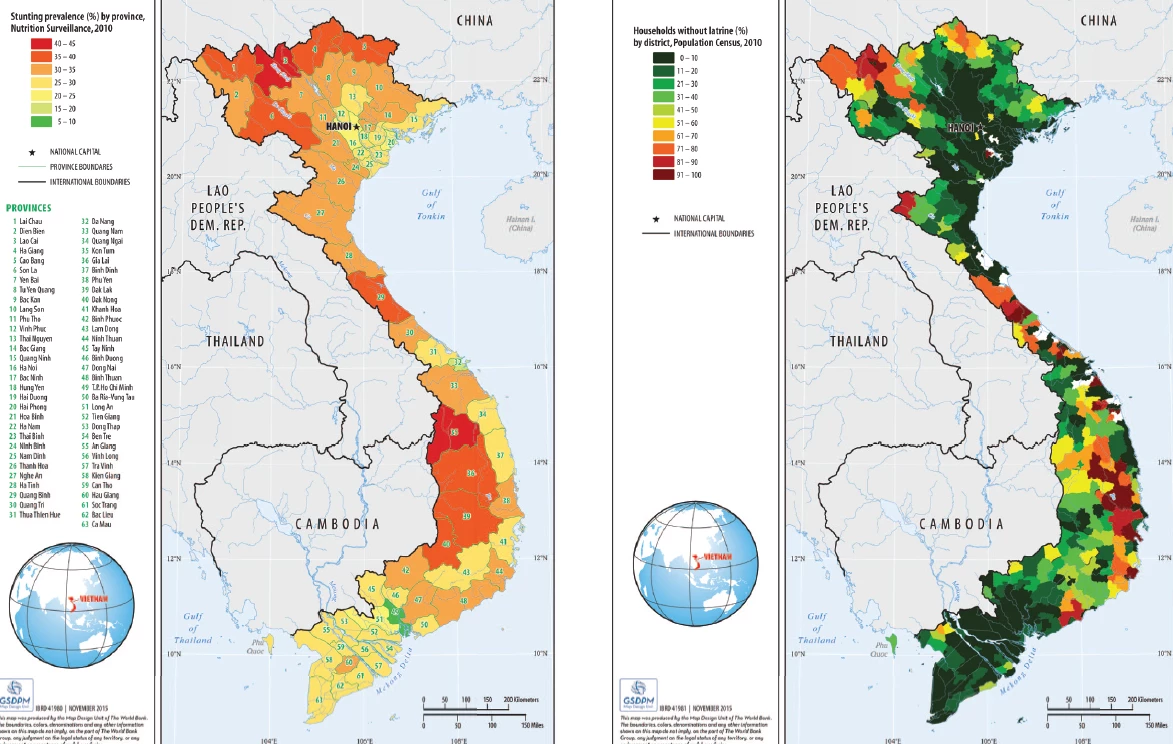
While child mortality rates have plummeted worldwide, nearly one-third of all children under 5 in developing countries are stunted . Children who are stunted (having low height-for-age) suffer from a long-term failure to grow, reflecting the cumulative effects of chronic deficits in food intake, poor care practices, and illness. The early years of life, especially the first 1,000 days, are critical; if a child’s growth is stunted during this period, the effects are irreversible and have lifelong and intergenerational consequences on their future human capital and potential to succeed.
For the water and sanitation community the year 2009 marked a turning point in our understanding of the role that Water, Sanitation and Hygiene (WASH) has on child stunting. A provocative Lancet article (Humphrey 2009) put forth the hypothesis that a key cause of child stunting is asymptomatic gut infection caused by ingestion of fecal bacteria. Small children living in poor sanitary environments are especially at risk, through frequent mouthing of fingers and objects during exploratory play, playing in areas contaminated with human and animal feces and ingesting contaminated food and water (Ngure et al. 2013). Researchers now estimate that up to 43 percent of stunting may be due to these gut infections, known as environmental enteric dysfunction (EED) (Guerrant et al. 2013).
Just last week estimates were released suggesting that poor sanitation is the second leading cause of child stunting worldwide (Danaei et al. 2016). In a key departure from previous work, the researchers defined risk as the sanitation level of a community, rather than an individual. This is consistent with mounting evidence showing that a community’s coverage of sanitation is more important than any one household’s (Andres et al. 2013). Across different studies, data sets and outcomes the evidence consistently shows that a threshold of around 60–70 percent household usage within a community is needed before the health and nutrition benefits of sanitation begin to accrue. Studies that have focused on an individual’s toilet use as a predictor, rather than a community’s use, may have vastly underestimated the impacts (Hunter and Prüss-Ustün 2016).
As we advance our understanding of the ways in which a poor sanitary environment impacts growth in small children, we can better design water and sanitation interventions to target these pathways. While there is a role for multi-sectoral interventions, which can simultaneously target the underlying determinants of child undernutrition, such as food security, access to health services, and childcare practices — there are ways that the water sector can adapt its own approaches so that they are more nutrition-sensitive, and more impactful on nutrition. Here are four key actions:
1. Use geographic targeting to reach populations where sanitation coverage is low and undernutrition is high.
Data visualization tools such as mapping can help visualize and target high burden areas. In Vietnam, for instance, poverty is concentrated in the Northern Mountains and Central Highlands regions of the country. These areas correspond with high rates of stunting and low coverage of sanitation. Mapping these outcomes side-by-side informed the design of the Scaling Up Rural Water Supply and Sanitation project in the region, which has a target of achieving commune-wide sanitation in 680 communities over the 5 years of the program.

Traditional WASH infrastructure investments may bypass some of the dominant fecal contamination pathways that affect small children. A new concept known as "baby WASH" or "child-centered WASH" is focused on interrupting exposure pathways that are most strongly associated with subsequent diarrheal disease. In rural Bangladesh 95 percent of soil samples taken from the child’s play area tested positive for E.coli. ( Ercumen et al., forthcoming) and this contamination was positively associated with subsequent diarrhea in young children ( Pickering et al. forthcoming). Sanitation interventions therefore need to include measures that ensure cleanliness of a child’s play environment, such as safe disposal of child and animal feces, and separation of livestock and domestic animals from the main housing compound.
3. Incorporate insights from behavioral economics to improve compliance and maximize impacts on nutrition.
Higher levels of investment in toilets alone will not be sufficient to meet nutrition objectives. Behavioral change is pivotal to realizing health outcomes of sanitation investments and is necessary to reap the rewards of those investments. Experience shows that just teaching people about these behaviors is not enough, since knowledge is already high in many contexts. Behavioral nudges, such as those advocated by behavioral economists, are a promising approach but have yet to be fully exploited to improve sanitation behaviors ( Coville and Orozco 2014). Hygiene behaviors — such as handwashing — have been shown to be amenable to nudging. In Bangladesh, after installing foot paths and stenciling footprints to physically and visually connect latrines to nearby handwashing facilities, primary school children were more likely to use the facilities to wash their hands with soap after using the toilet ( Dreibelbis 2016).
4. Incorporate nutrition-sensitive objectives and indicators into sanitation investments and policies.
What do we know from multi-sectoral approaches in other sectors? That it's critical for nutrition improving WASH interventions to include nutrition as a clear objective or indicator in the project design. Whereas WASH projects are required to report progress on core sector indicators at the output level (e.g., people provided with access to improved sanitation facilities) progress for nutrition-sensitive WASH projects needs to be measured at the outcome, and in some cases impact, levels. The Swachh Bharat Mission in India and the Scaling Up Rural Water Supply and Sanitation Program in Vietnam include reduction in open defecation and use of improved toilets as key result areas for disbursement under the Program-for-Results Financing instrument. Both projects thus recognize that infrastructure provision alone is not sufficient to achieve development results.
Sanitation has come a long way in a few years, from a taboo topic that few countries were willing to discuss openly, to one that continues to build international support through advocacy efforts by the international community. In fact, this Saturday (November 19) is the official UN World Toilet Day. Thanks to organizations including Global Citizen, over 100,000 people will gather in person and millions more virtually at the MMRDA Grounds in Mumbai for the first-ever Global Citizen Festival in India, to join international and Indian headliners including Jay Z, Coldplay and Bollywood star Aamir Khan, in mobilizing social change in sanitation, clean water, education and gender equality. I look forward to working with partners to continue building support for sanitation, especially by working with other sectors like education, gender and health, to approach sanitation as a solution with benefits in multiple areas.


Join the Conversation